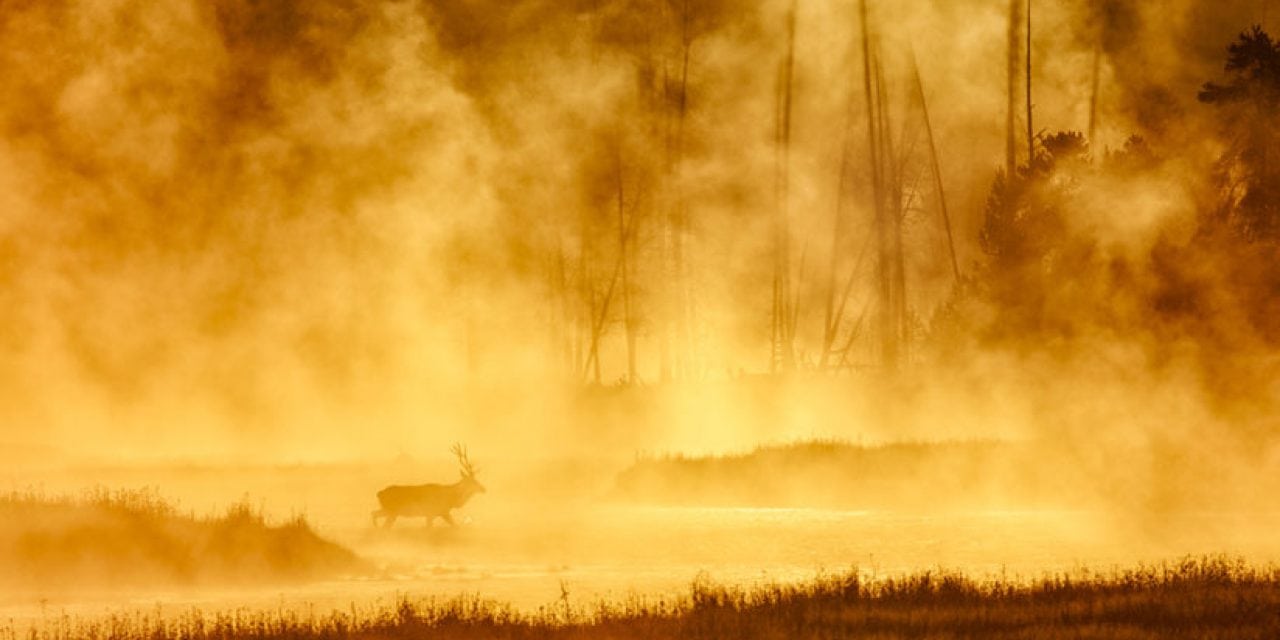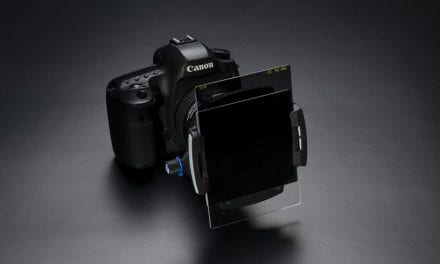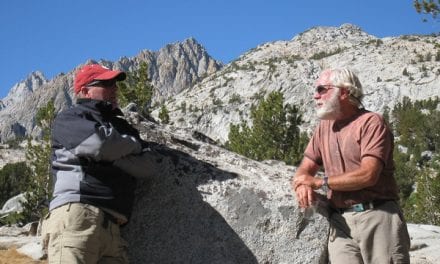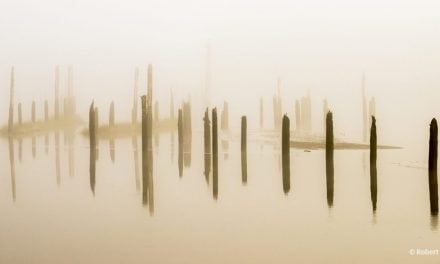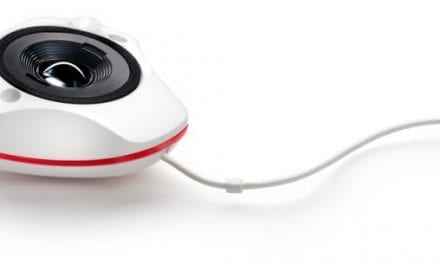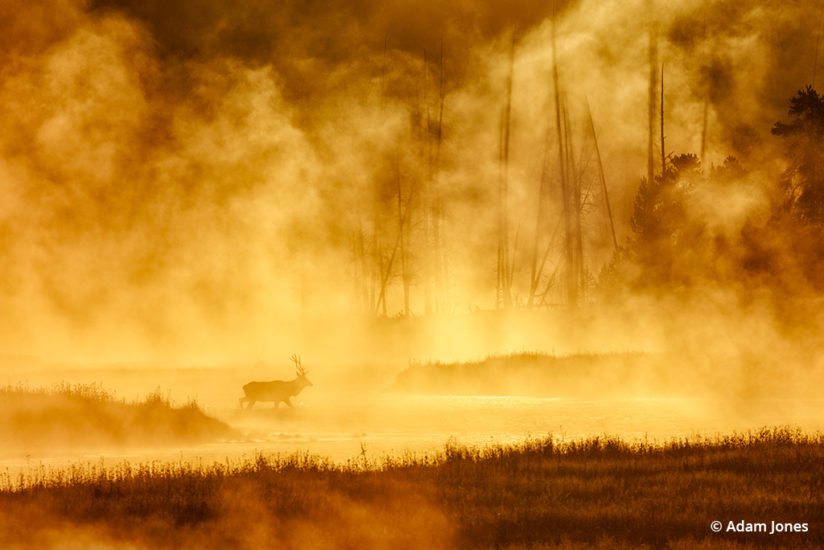
Adam Jones has been a nature photographer for more than two decades, but unlike many, he hasn’t narrowed his focus solely to wildlife or landscapes. All aspects of the natural world interest him, which is fitting for a photographer who travels regularly to shoot in one of North America’s premier destinations for photographing wildlife and landscapes. It’s Yellowstone National Park, where the flora and fauna and out-of-this-world nature of the land combine to form any outdoor photographer’s dream destination.
Outdoor Photographer: What drew you to first visit Yellowstone?
Adam Jones: First off, it was the wildlife that appealed to me. They call Yellowstone the Serengeti of North America because it’s considered the largest intact ecosystem in the lower 48. And I went there just to photograph elk and bison and deer and pronghorns like everybody else does, and hopefully some bears. I went there and actually, on my first trip, I was a little disappointed. I was like, “Man, this stuff’s a little bit harder to get than you would think,” other than the obvious bison and elk standing in a field doing nothing. But I went back and did a little better and started seeing all the other possibilities. All the patterns and colors, the steam, the grass… To me, some of those little frosty meadows in the mornings are just spectacular, and they only last a few minutes. Once the sun gets on them, it’s over.
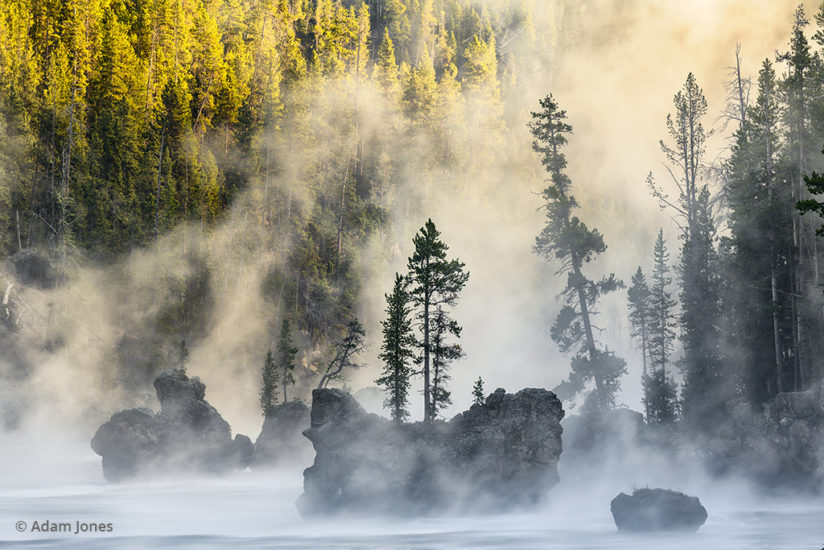
OP: What keeps you coming back year after year?
AJ: The park just offers so much, so many chances for wildlife and scenics and sometimes combining both. A lot of places I go, I know I’m doing pretty much nothing but wildlife or nothing but landscapes, and if you happen on to something else, great. But Yellowstone tugs at your heartstrings in both directions every time you enter the park.
OP: Do you plan your day according to the subject matter?
AJ: I like the “do what nature gives me” type of approach. I’m not a hardcore wildlife guy, nor am I a hardcore landscape guy. I like to do it all, and whatever nature’s giving me, that’s what I’m going to take. I am not a dyed-in-the-wool, hardcore wildlife guy. I love it, I go to Africa every other year and shoot there, and it’s almost 99 percent wildlife and that’s perfectly fine, but I know what I’m going there for. Yellowstone has such diversity of subject matter. Lighting, with all the steam vents and mist flying around the rivers on those cold mornings, it’s just magical. And I just don’t want to be sitting there chasing after some elusive wildlife while all this other fabulous stuff is going on right in front of me, and ignore that for the potential piece of North American wildlife that everybody’s seen before.

OP: If you’re interested in photographing a variety of things, Yellowstone seems ideal.
AJ: It certainly helps. I had a gentleman inquiring on our workshops, and he said “Well, what kind of photographer are you anyway? I was looking at your website and I can’t tell if you’re a nature guy or a landscape guy.” And I went and looked at his [website], and he was a pretty accomplished wildlife photographer, and I just honestly told him I don’t think this class is going to be for you. When I go out and take a group—because I don’t want to take 10 people with me and just be sitting around waiting for something to happen—we go to scenic destinations first. And if we encounter wildlife along the way, it’s just a bonus. That’s kind of how I approach the park. There are so many scenic, great places to be, I know I’m going to get something. And if wildlife happens to walk out in front of Old Faithful when it’s erupting at sunrise, then so be it. I’ll take it.
OP: Do you do a lot of post-production work? Your images look very natural.
AJ: That’s what I’m trying to go for: the way it really looks. I have stuff that’s over-polarized, and I look at it later and go, “What the crap was I thinking?” And I go in and I turn the blue down. I shoot everything in RAW, so every picture’s touched to some degree.
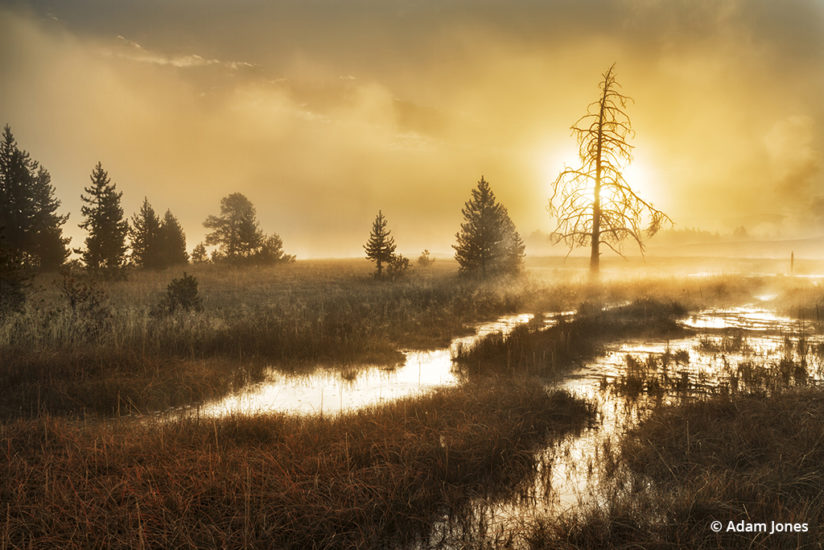
OP: Do most of your images have a polarizing filter to improve the saturation?
AJ: Yes, they are typically polarized but not always all the way. Now the color comes through. I don’t need a polarizer to make the sky blue at all, I just need it to get rid of shine and glare and so forth. If it’s not polarized, all the waxy leaves are shiny, and then you turn it and it’s gone crazy saturated and there’s the difference right there. The one thing you want to watch out for, on wide angles in particular, is not over-polarizing the sky. Because it polarizes just one side, and that looks awful. So occasionally I will combine two images, so if the full polarization really helps, say, the foreground land features, polarize that, then take it off or just turn it to where it’s not doing anything, and then just snap another one with sky even and then merge the two together. It’s easy to do; if you’ve got an even sky, you can make it as blue as you want.
OP: How frequently do you visit Yellowstone? Do you have a favorite time of year?
AJ: I’ve probably been there 15 times. In the last three years I’ve gone with Canon every September, teaching the EOS Destination Workshop. It sells out every year, so this year we’re doing two. I’m so happy to continue doing that, and occasionally we make it out in the spring. But September is my favorite, far and away my favorite. It can be pretty cool that time of year. It’s in the teens and 20s in the morning. Sometimes it’s in the 30s and it may get up to 75 during the day when it’s sunny. So you’ve got to leave all dressed up like it’s wintertime, and then by lunchtime you’re running around in a T-shirt. It’s cool and crisp and it’s good weather, or good atmospheric conditions, anyway. But the main thing is that the wildlife is in prime condition. The elk have already pretty much completed most of their rutting and dueling for their harems and everything, but they have their harems rounded up, and the big bull elks are in their prime, and they’re bugling and they’re keeping their girls all together and herded up. And your coyotes and wolves and deer are all in prime coats. And the bison. If you go out there in June, the bison have all pieces of shaggy wool on them the size of hubcaps falling off, and it’s not real attractive. The other reason to come in September is the crowds are gone. The kids are back in school, the vacationers are usually gone, and the park generally is deserted. It’s not deserted, but…You know, wildlife guys like to have the whole park to ourselves.
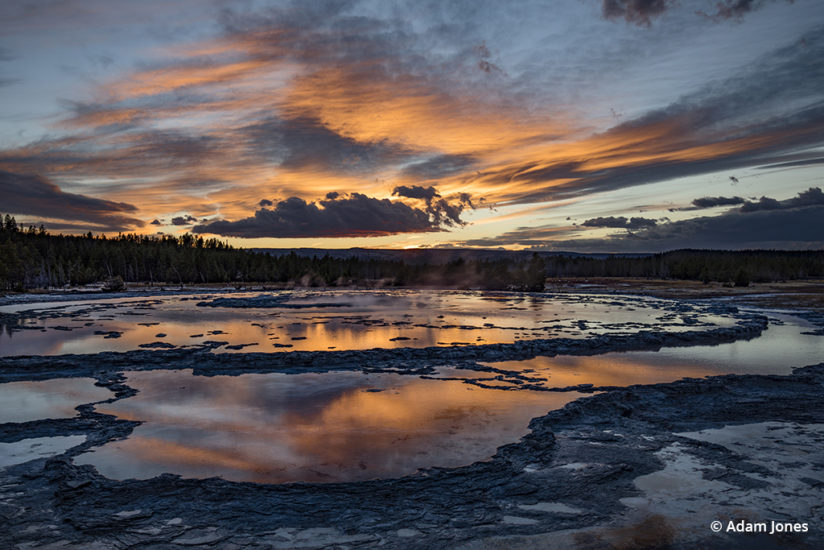
OP: If you were advising young photographers on their first visit to Yellowstone, where should they visit first?
AJ: It could be anywhere. Madison Junction is a favorite area. I would hit all the major big spots. I think the ideal trip to Yellowstone would be to spend two or three days at the north end, coming in up around Gardiner and then two or three days over at West Yellowstone or the lake or something like that. Just explore completely different ends of the park, because it’s a huge park to try to cover the whole thing. That’s one of the reasons I just keep picking a few spots.
OP: Some folks balk at photographing popular locations.
AJ: Well, yeah, I totally get that. I tell everybody at my workshops who wants to make money, don’t go to the popular overlooks because that’s not going to make you any money. But if you haven’t been to Yellowstone and it’s your first time, you certainly want to go see those things. I couldn’t agree more. It’s always fun to find the next new place or visit someplace new, but it’s all about the light for me. You’ve got to shoot what light is available, and I’m trying to put myself in locations I know where the light is going to be coming from and how it’s going to interact and collide with the graphics.

OP: What equipment is crucial?
AJ: A tripod. Actually, a sturdy tripod. Some people have these little flimsy, junky tripods that aren’t capable of keeping anything steady. Polarizing filters for your landscapes, that’s another one. I preach that all the time. People ask me how I get this great color, and I say, well, the polarizing filter sure is helping. If I were going tomorrow, I’d take two camera bodies, one full frame, the 5D Mark IV, which I truly love, and then the 7D Mark II, which surprises a lot of people because it’s not the high-end wildlife camera. But what I like about that is the 1.6x crop factor. It’s 20 megapixels, ten frames per second, and now I’ve got a 160-640mm when I take my 100-400mm lens with me. And the new 100-400mm lens is just extraordinary. It’s a hand-holdable little outfit that fits in your camera bag, and you take it everywhere you go. So now I don’t have to take the big gimbal head, I don’t have to haul my 500mm out there. It just all adds up, and it makes you more dedicated to shooting wildlife. I can be on the fly and switch back and forth without having camera bodies all over me, because I hate camera straps. I just don’t like things hanging on me.
OP: You utilize the long lens for landscapes, too?
AJ: I do. I would be the first to admit, I love landscapes, but I make sure that I pick the lens that gives me what I’m seeing—whatever’s going to record it. I don’t just jump out with a wide angle and go, “I’m going to make something work because you’ve got to shoot wide angle for landscapes.” I see it in my head first, in my mind, and then I pick whichever tool will get the job done. The image of rocks and steam rising from the Yellowstone River, that’s one of my favorite shots that I’ve done recently that I consider a landscape, and it’s a telephoto landscape. About a 300mm lens; 275mm actually. It’s a shot everybody drives right past. It’s right as you go into the Grand Canyon of the Yellowstone, you cross over a big tall bridge going over the Yellowstone river, stand in one corner, and you shoot down to the other corner. It’s not early morning and it’s not 10 o’clock, but it takes a little while for the light to get down in there. I love the separation that the fog gives the rocks and the trees silhouetted on top of there. Without the mist in there, it just looks like nothing.
See more of Adam Jones’s work and get info about his Canon EOS Destination Workshops in Yellowstone at adamjonesphoto.com.
The post Destination Yellowstone appeared first on Outdoor Photographer.


